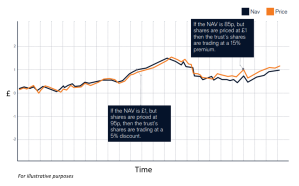Investment trusts explained
Discover investment trusts
Explore the unique features of investment trusts and how they work
Marketing Communication. Past performance does not predict future returns. The value of an investment and the income from it may go down as well as up and you may lose the amount originally invested.
What is an investment trust?
An investment trust is a public limited company, listed on the London Stock Exchange. To invest, an investor buys shares in the investment trust, becoming a shareholder. The investment trust provides shareholders with an expertly chosen selection of stocks, bonds or other types of investments such as property. The purpose of an investment trust is to grow its shareholders’ investment value or provide an income stream. Each trust has its own investment objective.
What are the unique features of investment trusts?
-
1
Dividend smoothing
Investment trusts are able to save a portion of the income they receive from their investments to create revenue reserves. The trust can add to these reserves in years of strong dividend growth and use them to add to what they pay shareholders in leaner years, thereby smoothing the level of dividend payments when appropriate.
-
2
Gearing
Investment trusts can use ‘gearing’ with the aim of enhancing the portfolio returns. This is done by borrowing money in order to buy investments. Each trust will have a limit on how much of the portfolio can be geared. Gearing can positively enhance performance when the returns generated are above the cost of borrowing. Conversely gearing can enhance losses if the returns are negative.
-
3
Long term view
As they consist of shares listed on the London Stock Exchange, investment trusts have what is referred to as ‘permanent capital’. This means that in periods of poor performance, the manager does not have to sell investments to return money to investors . Instead, the value of the shares will fall. Equally, when the trust is successful, the investment trust cannot “issue” new shares without the approval of existing investors. Some investment trusts have been running for decades, like The Bankers Investment Trust, which was founded in 1888.
-
4
Board of directors
All investment trusts have an independent board of directors who oversee the company and represent shareholder interests. The board engages a professional fund manager such as Janus Henderson Investors, to make investment decisions on behalf of the investment trust.
-
5
Investors are shareholders
To invest in an investment trust, you must buy its shares. This means that an investor in an investment trust is a shareholder in it. This comes with rights, including the right to vote on proposals put forward by the board, such as a change of investment manager or whether to pay a dividend.
Key investment trust terms
Investment trusts come with an extra layer of language compared to other investment funds because of their status as public companies. However, this is not as complicated as it first looks. There are two sets of terms that explain the price and value of a trust.
Net Asset Value (NAV): the total value of the investments held by the trust, minus any money it has to pay out (liabilities) then divided by the number of shares.
Share Price: the share price is affected by supply and demand, so differs from the NAV. This is the price you will pay or receive when buying or selling shares in a trust.
Premium: When the shares of a trust are selling for more than the NAV per share, the trust is trading at a premium.
Discount: When the shares of a trust are selling for less than the NAV per share, the trust is trading at a discount.
NAV vs Share Price

How are Investment Trusts different to funds
| Investment Trusts | Investment Funds (OEICs or unit trusts) |
|---|---|
| Investment trusts issue a fixed number of shares (which can only be increased with the approval of existing shareholders) and are sometimes referred to as closed-ended. | Investment funds can freely create new shares to meet investor demand, making them open-ended. |
| To invest in a trust, you buy shares from someone willing to sell them. | To invest in a fund new ‘units’ can be created according to demand, causing the fund to grow in size. |
| In times of market stress, the fund manager does not have to sell investments if investors wish to sell their shares. The share price will move as investors sell their shares. | When an investor leaves, the fund shrinks in size. In extreme conditions, if lots of people move their money out of the fund, assets must be sold to repay them, potentially at a loss. |
| Investment trusts are overseen by an independent board of directors. | Funds do not have an independent board of directors. |
What are the risks of an investment trust?
- Across all trusts, the share price can rise and fall, independent of the investment performance.
- The income paid out by an investment trust in the form of dividends can also rise and fall.
- The amount of risk you take will often depend on the type of asset invested in, or the number of underlying assets.
- How easily and quickly the fund manager can buy or sell the underlying asset (known as liquidity) also affects risk.
- The value of an investment and the income from it can fall as well as rise as a result of market fluctuations and you may not get back the amount originally invested.